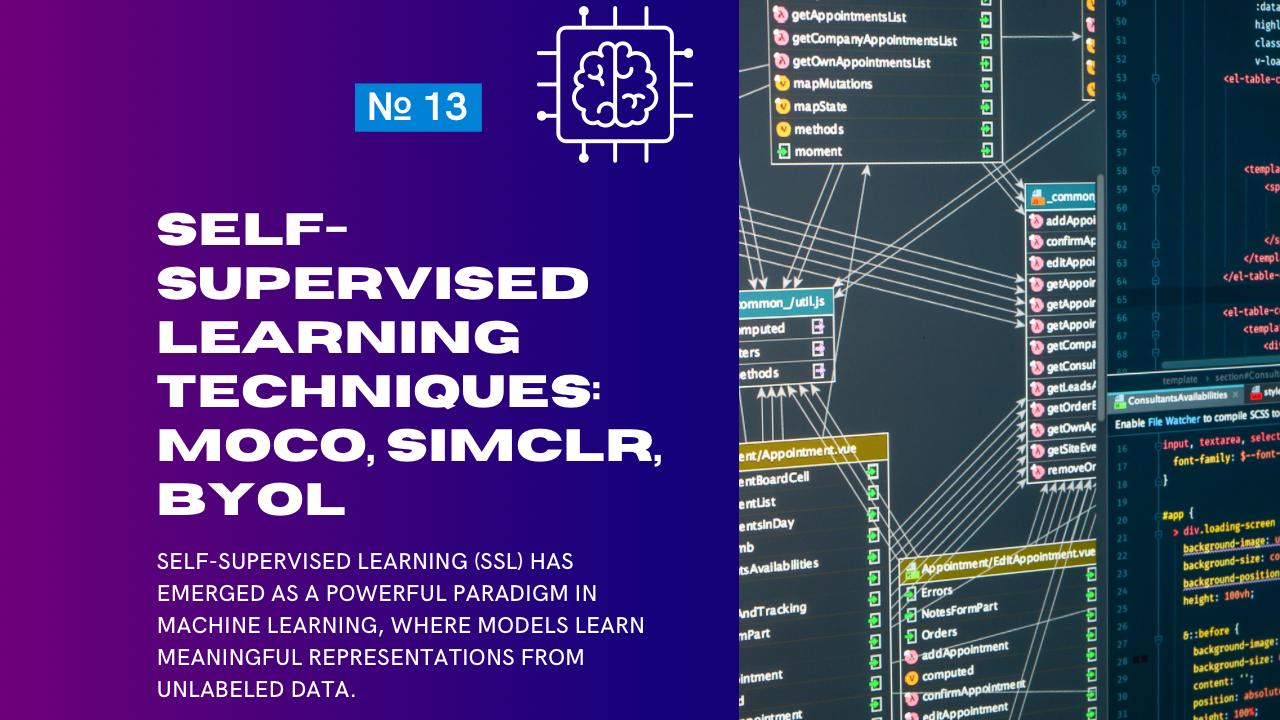Self-supervised learning (SSL) has emerged as a powerful paradigm in machine learning, where models learn meaningful representations from unlabeled data. Techniques like MoCo, SimCLR, and BYOL are pioneering methods in this domain, particularly in computer vision. These methods rely on contrastive learning or similar frameworks to generate representations that generalize well to downstream tasks.
What is Self-Supervised Learning?
Self-supervised learning uses unlabeled data to create a supervision signal, typically by defining pretext tasks. In computer vision, this involves learning features by predicting relationships between different parts of an image or multiple augmented views of the same image.
Key SSL Techniques
| Technique | MoCo | SimCLR | BYOL |
|---|---|---|---|
| Full Name | Momentum Contrast | Simple Contrastive Learning of Representations | Bootstrap Your Own Latent |
| Year Introduced | 2020 (Facebook AI) | 2020 (Google Research) | 2020 (DeepMind) |
| Core Idea | Contrastive learning using a momentum encoder. | Contrastive learning with extensive augmentations. | Self-supervised representation learning without negative pairs. |
| Key Difference | Uses a dynamic dictionary with momentum. | Simpler design, no momentum encoder. | No need for negative pairs or explicit contrast. |
1. Momentum Contrast (MoCo)
Core Idea:
MoCo builds a dynamic dictionary to store representations of previous samples, enabling contrastive learning at scale. It uses a momentum-based encoder to maintain consistency in dictionary keys over time.
How it works:
- Input images are augmented into two views: a query and a key.
- The query is encoded using the main encoder, while the key is encoded using a momentum encoder.
- Contrastive loss encourages the query to be similar to its positive key and dissimilar to negatives.
Key Features:
- Momentum Encoder: Updates slowly to maintain stable representations over time.
- Large Dictionary: Stores many negative samples efficiently.
- Flexibility: Can be used with various encoders, such as ResNet.
Advantages:
- Handles a large number of negatives efficiently.
- Maintains stable representations due to momentum updates.
Limitations:
- Complexity due to maintaining a momentum encoder and a large dictionary.
2. Simple Contrastive Learning of Representations (SimCLR)
Core Idea:
SimCLR eliminates the need for additional components like a momentum encoder or memory bank. It achieves state-of-the-art results by relying heavily on data augmentation and a simple contrastive loss.
How it works:
- Generate two augmented views of each image.
- Pass both views through the same encoder network.
- Use contrastive loss to maximize similarity between positive pairs (same image) and dissimilarity between negative pairs (different images).
Key Features:
- Focuses on augmentation (e.g., random crops, color distortion) to create diverse views.
- Uses a projection head to map latent features to a lower-dimensional space for contrastive loss computation.
Advantages:
- Simpler to implement compared to MoCo.
- No additional momentum encoder or memory bank required.
Limitations:
- Requires a large batch size to generate sufficient negative pairs.
- High computational cost due to large batch sizes.
3. Bootstrap Your Own Latent (BYOL)
Core Idea:
BYOL avoids the use of negative pairs entirely. It learns meaningful representations by encouraging the agreement between two augmented views of the same image, using a teacher-student framework.
How it works:
- Generate two augmented views of the same image.
- Pass one view through a student network and the other through a teacher network.
- Minimize the difference between the representations from the two networks.
Key Features:
- Teacher-Student Framework: The teacher network provides stable targets for the student and is updated using an exponential moving average (EMA) of the student weights.
- No contrastive loss or explicit negatives required.
Advantages:
- Simpler training compared to MoCo and SimCLR.
- Works well even with smaller batch sizes.
- No reliance on negative samples, reducing computational overhead.
Limitations:
- Theoretical understanding of why BYOL works is still evolving.
- Slightly more complex implementation due to the EMA mechanism.
Comparison Table
| Aspect | MoCo | SimCLR | BYOL |
|---|---|---|---|
| Type of Learning | Contrastive | Contrastive | Predictive |
| Negative Pairs Required | Yes | Yes | No |
| Additional Components | Momentum encoder, memory bank | None | Exponential moving average (EMA) for teacher. |
| Batch Size Dependence | Moderate | High | Low |
| Computational Cost | Moderate | High | Moderate |
| Main Advantage | Scales well with large dictionaries. | Simplicity and effectiveness with large batches. | No need for negatives, robust with smaller batches. |
Performance and Use Cases
| Technique | Best For | Example Applications |
|---|---|---|
| MoCo | Large-scale datasets with computational resources to maintain a momentum encoder. | Image classification, object detection. |
| SimCLR | Scenarios where large batch sizes and extensive augmentations are feasible. | Pretraining for vision tasks with large datasets. |
| BYOL | Scenarios with limited resources, smaller datasets, or when negative pairs are hard to define. | Pretraining for edge devices, fine-tuning small-scale datasets. |
Challenges in Self-Supervised Learning
- Computational Costs:
- SimCLR requires massive batch sizes, making it resource-intensive.
- MoCo and BYOL address this with more efficient frameworks.
- Augmentation Design:
- The quality of augmentations directly impacts the learned representations.
- Over-reliance on specific augmentations may lead to overfitting.
- Scalability:
- Scaling self-supervised learning to domains like video or 3D data requires additional innovation.
Conclusion
- MoCo is ideal for large-scale datasets and scenarios where maintaining a large dictionary is feasible.
- SimCLR offers simplicity but is resource-intensive due to its dependence on large batch sizes.
- BYOL simplifies the process by removing negatives and works well in resource-constrained environments.
